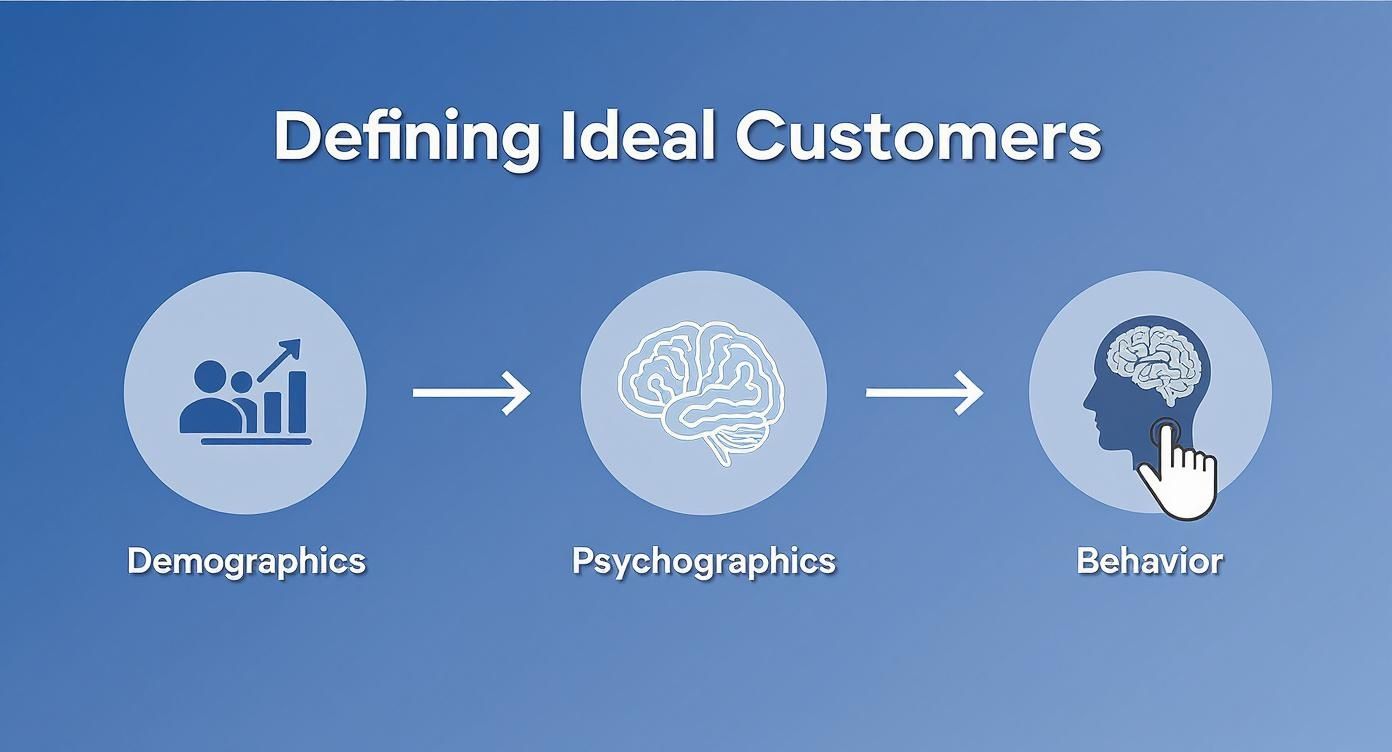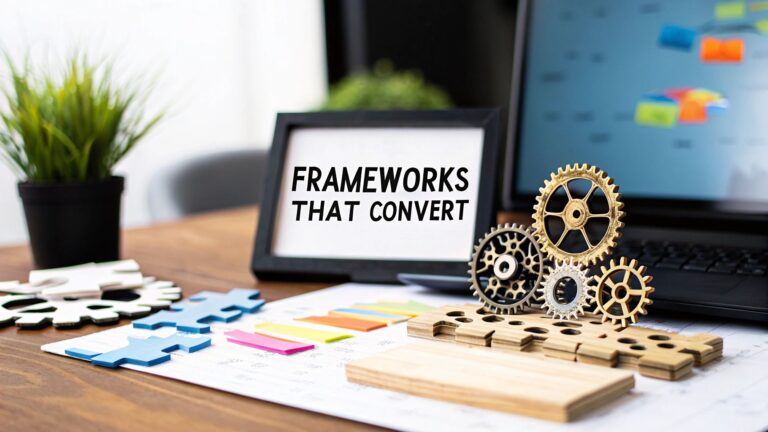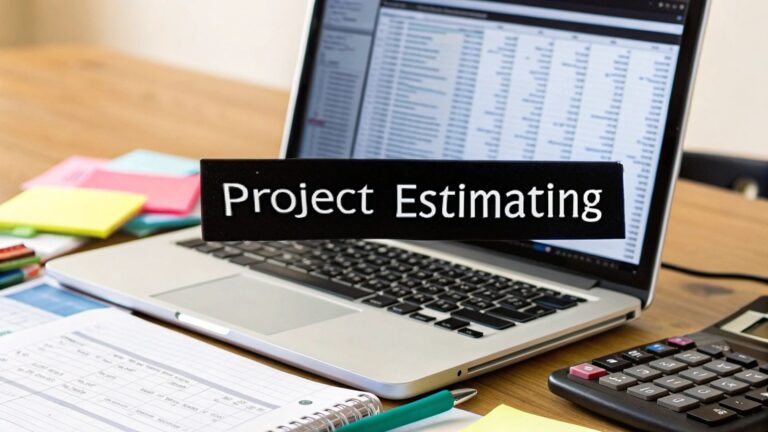How to Qualify Sales Leads and Win More Deals
Qualifying a sales lead is all about figuring out which prospects are serious buyers and which are just kicking the tires. The most effective way to do this is by first defining exactly who your Ideal Customer Profile (ICP) is, then building a smart, data-driven lead scoring system. Top it off with the right technology to automate the busywork, and you've got a recipe for success.
This method gets your sales team focused on conversations that actually lead to revenue, not just endless follow-ups with window shoppers.
Stop Wasting Time on Unqualified Leads
Every seasoned sales professional has felt the sting of a deal gone cold. You pour weeks, maybe even months, into what feels like a sure thing, only to have it evaporate. That's not just bad luck—it’s often a clear sign of a weak or nonexistent lead qualification process.
When there's no system in place, sales teams end up chasing every single lead that comes through the door with the same amount of energy. It’s a reactive approach that burns through time, morale, and resources.
Effective lead qualification acts as a strategic filter, separating the high-potential buyers from the merely curious. It’s a fundamental shift from a volume-first mindset to a value-first one. Let's be honest, not all leads are created equal. In fact, industry research shows that only about 25% of marketing-generated leads are ready for a sales conversation.
This statistic is telling. It points to a massive gap where the other 75% of leads either need more nurturing or are simply a bad fit from the start. You can dig deeper into these kinds of impactful sales statistics and their implications.

The Foundation of an Efficient Sales Pipeline
Putting a solid qualification framework in place isn't about adding more hurdles; it's about adding the right ones. This structure transforms a messy, unpredictable sales funnel into a well-oiled machine that consistently produces results.
A disciplined approach brings some major wins:
- Boosted Sales Team Productivity: Reps can finally stop spinning their wheels on dead-end leads and concentrate their skills on prospects who are genuinely interested and have the authority to buy.
- Higher Conversion Rates: When you're only talking to well-vetted prospects, your win rate naturally goes up. It's a simple numbers game.
- More Accurate Forecasting: A pipeline full of genuinely qualified opportunities makes sales forecasting far more reliable. No more guesswork.
- Tighter Sales and Marketing Alignment: When both teams agree on what a "qualified lead" looks like, the handoff becomes seamless. Marketing sends better leads, and sales closes more of them.
To get this right, your strategy needs to be built on a few core principles. Think of them as the three pillars holding up your entire qualification process.
The Three Pillars of Effective Lead Qualification
A strong qualification process boils down to three key areas. Getting these right provides the clarity and structure needed to turn a messy pipeline into a predictable revenue engine.
| Pillar | Objective | Key Action |
|---|---|---|
| Ideal Customer Profile (ICP) | Define precisely who your best customers are. | Analyze your current top customers to identify common firmographic, technographic, and behavioral traits. |
| Lead Scoring | Quantify a lead's sales-readiness. | Assign points to leads based on their profile data (e.g., job title, company size) and their actions (e.g., downloaded an ebook, visited the pricing page). |
| Automation & Technology | Streamline the qualification and routing process. | Use CRM and marketing automation tools to automatically score leads, assign them to the right reps, and trigger follow-up tasks. |
By building your process around these pillars, you create a repeatable system that scales with your business.
The goal is straightforward: focus your best resources on your best opportunities. A disciplined qualification process is the most direct path to making that happen, turning your sales efforts into a strategic advantage instead of a game of chance.
Ultimately, knowing how to qualify sales leads isn't just a short-term tactic to close a few more deals this quarter. It's about building a sustainable, scalable engine for growth that minimizes wasted effort and drives real ROI for years to come.
Define Your Ideal Customer and Qualification Framework
You can't qualify leads if you don't know who you're looking for. It's that simple. Before you can start sorting the good leads from the bad, you have to get incredibly clear on what a "good" lead actually looks like for your business. This isn't just about company size or industry, either—it's much deeper than that.
A truly effective Ideal Customer Profile (ICP) is a detailed, multi-dimensional portrait of your perfect buyer. It's where you combine hard data like demographics and firmographics with the softer, more meaningful insights that drive decisions. Getting this right is the first, most critical step. For a solid foundation, start with creating effective buyer personas, which will feed directly into your ICP.
Building Your Ideal Customer Profile
Want to know what your ideal customer looks like? Look at the ones you already have. Your best ICPs are built by analyzing your happiest, most successful customers—the ones who get the most value, stick around the longest, and are a pleasure to work with. Find the common threads.
-
Demographics & Firmographics: This is your starting point. Think quantifiable data: industry, company size, annual revenue, geographical location, and the specific job titles you're targeting.
-
Psychographics: This is where you add the "why." What are their core motivations, business goals, and biggest headaches? You need to understand what keeps them up at night to position your solution effectively.
-
Behavioral Data: Actions always speak louder than words. Pay attention to what they do. Are they downloading technical whitepapers or are they watching high-level strategy webinars? Their digital footprint tells you their priorities and how far along they are in their buying journey.
When you layer all this together, you transform a generic target into a highly specific profile. You’re no longer just looking for a "VP of Marketing at a SaaS company." Now, you’re searching for a "VP of Marketing at a Series B SaaS company with 50-200 employees who recently downloaded a case study on customer retention." That's a game-changer.
Choosing the Right Qualification Framework
Once you know exactly who you're looking for, you need to give your sales team a structured way to find them. That's where a qualification framework comes in. Think of it as a standardized playbook that ensures every rep is evaluating leads against the same vital criteria.
These frameworks aren't meant to be rigid scripts. They're guides—a set of questions designed to uncover the information you need to decide if a lead is worth a sales rep's valuable time. If you want to explore the different methodologies, it's worth taking a look at these sales qualification frameworks to see what might fit your process.
Common Frameworks for Different Sales Cycles
The right framework for you really depends on the complexity of your sale. A straightforward, transactional product requires a very different approach than a massive, multi-stakeholder enterprise deal.
BANT for Straightforward Sales
First developed by IBM, BANT is the classic. It's simple, direct, and has stood the test of time for a reason. It’s perfect for shorter sales cycles with just a few decision-makers involved.
- Budget: Can they actually afford your solution?
- Authority: Is this the person who can sign on the dotted line?
- Need: Do they have a real pain point that you can solve?
- Timeline: When are they looking to make a decision?
If you sell a product with a clear price and value prop, BANT is a fantastic place to start.
Real-World Scenario
A rep for a project management tool gets on a call with a small marketing agency. They quickly confirm the agency has a budget set aside (Budget) and that they’re speaking with the owner (Authority). The owner complains their team is struggling with messy workflows (Need) and wants a fix before the next quarter (Timeline). Boom. The lead is qualified.
MEDDIC for Complex Enterprise Deals
When you’re navigating a nine-month sales cycle with six different departments, you need a more powerful tool. MEDDIC is built for these complex environments. It forces your team to dig deep, identify internal champions, and truly understand the customer's buying process.
- Metrics: What are the quantifiable results they need to see?
- Economic Buyer: Who holds the ultimate P&L responsibility for this?
- Decision Criteria: What specific, non-negotiable requirements must be met?
- Decision Process: What are the exact steps they follow to sign a contract?
- Identify Pain: What’s the real business impact of their current problem?
- Champion: Who inside their company loves you and is selling on your behalf?
MEDDIC is all about deep discovery, which is absolutely essential when a big deal is on the line.
Ultimately, your goal is to pick—or even customize—a framework that helps your team ask the right questions, every single time. This structure ensures that the leads you pass to your closers are genuinely ready for a sales conversation, which makes your entire pipeline more efficient and dramatically boosts your close rates.
Build a Lead Scoring Model That Actually Works
Once you've got a solid handle on who you're selling to, it's time to stop guessing and start measuring. A good lead scoring model is your secret weapon, moving you beyond gut feelings and into a system that assigns a numerical value to every single prospect. It’s a data-backed method for quantifying interest, making sure your sales team invests their energy on leads who are actually ready to talk.
The idea is straightforward: you award points for specific traits and behaviors. Some of these are based on explicit data—the hard facts a lead gives you. Others come from implicit data—the digital breadcrumbs they leave that signal their interest level.
Assigning Points for Explicit Data
Explicit scoring is all about fit. How closely does a lead match your Ideal Customer Profile (ICP)? This is where you look at firmographic and demographic info to see if they’re a good match on paper. You're basically giving points to prospects who look a lot like your best customers.
Here’s how that might break down:
- Job Title: A "VP of Sales" is a decision-maker and could get +10 points. A "Marketing Intern," on the other hand, might just be doing research, so they get +1 point.
- Industry: If you specialize in SaaS solutions, a lead from a tech company is a great fit, earning +15 points. A lead from an industry you don't serve might get 0 points.
- Company Size: Is your sweet spot companies with 100-500 employees? A lead from a business that size could get +10 points, while a solo entrepreneur gets +2 points.
- Location: If your services are limited to a certain region, leads from that area should score much higher than those outside of it.
This part of the process immediately flags the leads who are a natural fit for your business.
Tracking and Scoring Implicit Actions
Now for the fun part: implicit scoring. This is where you measure a lead's digital body language—their engagement with your brand. What are they clicking? What are they downloading? These actions are powerful indicators of their buying intent.
This visual gives you a great, simplified look at how a model combines explicit data (like job title) with implicit actions (like requesting a demo).

As you can see, high-intent actions like asking for a demo are worth way more than passive ones like just opening an email. This is how you separate the window shoppers from the serious buyers.
Here’s a practical example of how you could assign points:
- Visiting the pricing page: +15 points (This is a huge buying signal!)
- Downloading a detailed case study: +10 points
- Subscribing to your newsletter: +5 points
- Opening a marketing email: +3 points
This tiered system lets you see, at a glance, who is actively exploring a solution versus who is just casually browsing.
Pro Tip: Don't sleep on negative scoring. It’s a fantastic way to automatically weed out the wrong people. For instance, you can subtract points for certain red flags.
- Visiting the careers page: -10 points (They want a job, not your product.)
- Using a generic email domain (@gmail.com): -5 points
- Listing "Student" as their job title: -25 points
This keeps your pipeline clean and saves your sales team from chasing down leads who were never going to buy in the first place.
Setting Clear Thresholds for Handoffs
A scoring model is only as good as its thresholds. These are the point values that trigger an action, creating a smooth, automated handoff from marketing to sales. Without clear lines in the sand, hot leads can fall through the cracks.
Think of it as setting up a tiered system based on sales-readiness.
Example of Lead Thresholds in Action:
| Lead Type | Score Threshold | What It Means | Next Step |
|---|---|---|---|
| Lead | 1-49 points | Just getting warm. They’ve shown some interest but aren't ready for a sales call. | Keep them in a marketing nurture sequence with helpful content. |
| MQL | 50-99 points | Marketing Qualified Lead. They fit your ICP and are actively engaged. | Marketing can send more targeted content, like a webinar invite or a specific case study. |
| SQL | 100+ points | Sales Qualified Lead. This is the real deal—a perfect fit, highly engaged, and showing clear buying intent. | The lead is automatically routed to a sales rep for immediate, personalized follow-up. |
These thresholds give everyone on the team a clear, shared definition of what a "sales-ready" lead looks like. That alignment between marketing and sales is priceless. To really nail this down, check out these lead scoring best practices for a deeper dive.
By putting a thoughtful scoring model in place, you’re swapping subjective hunches for objective data. This not only makes your team more efficient but also builds a more predictable and scalable pipeline. To take it even further, digging into more advanced lead scoring best practices can help you get the absolute most out of every channel. It's all about helping your team work smarter, not harder.
Automate Your Qualification Process with the Right Tech
Trying to score, track, and route leads by hand is like trying to direct rush-hour traffic with a stop sign. It’s slow, full of mistakes, and you simply can't keep up when things get busy. To really nail lead qualification today, you need a tech stack that does the heavy lifting for you.
This isn’t about replacing your salespeople; it’s about making them better. The right technology frees them up from administrative busywork so they can focus on what they do best: building relationships and closing deals.
Your CRM is Command Central
Think of your Customer Relationship Management (CRM) platform—whether it's Salesforce, HubSpot, or another—as the single source of truth for everything lead-related. This is where your lead scoring model comes to life. Instead of fumbling with spreadsheets, you build rules that automatically update a lead’s score as they interact with your brand.
For example, a prospect with the title "Director of Operations" (a clear sign of authority, let's say +10 points) visits your pricing page (a huge buying signal, +15 points). Your CRM should instantly recalculate their score to reflect that high-intent combination. This real-time processing is what makes an efficient qualification system tick. If you're new to this, understanding what is CRM integration is fundamental to connecting these systems seamlessly.
Speed Up with Automated Lead Routing
In sales, speed is everything. Study after study shows that your odds of actually connecting with a lead plummet just minutes after they reach out. That's why automated lead routing isn't a luxury; it's a necessity.
The second a lead hits your Sales Qualified Lead (SQL) threshold—let's call it 100 points—your CRM should kick off an automated workflow. This isn’t just about sending a notification. It's about taking immediate action.
- Territory-Based Assignment: The system can instantly assign the lead to the rep covering their specific state or country.
- Industry Specialization: Got reps who are experts in SaaS or healthcare? The lead gets routed directly to them.
- Round-Robin Distribution: You can set it up to pass leads to the next available rep in a queue, ensuring everyone gets a fair shot.
This instant handoff gets rid of the dreaded bottleneck where hot leads sit in a queue, getting colder by the minute while waiting for someone to manually assign them.
The moment a lead becomes sales-qualified is a critical window of opportunity. Automation ensures you never miss it. By instantly assigning the lead and creating a follow-up task, you maximize the chances of a meaningful conversation while the lead's interest is at its peak.
Nurture the Leads Who Aren't Ready Yet
So, what about the leads who look like a great fit on paper but just aren't ready to talk to sales? These are your Marketing Qualified Leads (MQLs), maybe with a score between 50–99. Shoving them over to a sales rep too early is a fantastic way to annoy them.
Instead, this is where marketing automation platforms shine. When a lead falls into this "warm-but-not-hot" category, they can be automatically dropped into a nurture sequence. This isn't a generic email blast. It’s a series of helpful, targeted communications designed to keep you on their radar and gently guide them closer to a decision.
Here’s what a nurture workflow might look like:
- A lead downloads your new ebook. They immediately get a thank-you email with a link to a related blog post.
- Three days later, they receive an invitation to an upcoming webinar that dives deeper into the same topic.
- A week after that, they get a case study showing how a company just like theirs solved the exact problem they're facing.
Every one of these engagements adds a few more points to their lead score. Once they finally cross that SQL threshold, the system automatically pulls them out of the nurture campaign and routes them straight to sales.
AI is Changing the Game
Artificial intelligence is taking all of this a step further. It adds a layer of predictive insight that older, rule-based systems just can't match. AI tools can analyze mountains of data to spot the subtle patterns your team would never see, pinpointing the highest-potential leads with scary accuracy.
Here are a couple of ways AI is already making a huge impact:
- Intelligent Chatbots: The chatbots on websites today are more than just FAQ machines. They can ask smart qualifying questions—like company size, job title, and biggest challenges—and score the lead right there in the chat. If it's a hot prospect, the bot can even book a demo directly on a sales rep's calendar.
- Predictive Lead Scoring: This is the real magic. AI models can chew through your historical sales data—all your wins and losses—to figure out what a perfect customer actually looks like. The model then scores new leads based on how closely they match that ideal profile, often uncovering non-obvious traits that correlate with a closed deal.
By weaving these technologies together, you create a powerful, self-running system. It doesn’t just find your best leads; it makes sure they get the right attention at the perfect time. This is how you scale your sales efforts and turn your qualification process into a serious competitive advantage.
Master the Human Side of Lead Qualification

All the lead scoring models and automation workflows in the world only get you so far. They give you the data, sure, but conversations are where deals are actually won. The human element is where you get to validate everything your tech has told you and uncover the context a scoring model just can't see.
This is your chance to turn a qualification call from an interrogation into a genuine discovery session. Your goal isn't just to robotically check off boxes on a framework like BANT. It's to understand the story behind those data points. A great call builds instant rapport and positions you as a helpful consultant, not just another salesperson.
Moving Beyond the Checklist with Open-Ended Questions
Leaning too heavily on a rigid framework can make conversations feel stiff and transactional. To really get a feel for a prospect's world, you need to ask questions that invite a story, not just a "yes" or "no." This is how you unearth the real business challenges keeping them up at night.
So, ditch the script and get curious. Try questions like these:
- "Could you walk me through what your team’s current process for [relevant task] looks like?"
- "What’s the biggest roadblock you’re hitting when you try to achieve [business goal]?"
- "If you could wave a magic wand and fix one thing about [their area of responsibility], what would it be and why?"
- "What happens if you don't find a solution for this in the next six months?"
These kinds of questions open the door to real dialogue. You’ll learn about their specific pains, their motivations, and the actual impact their problems are having on the business.
Navigating Common Hurdles with Confidence
Let's be real—not every call is a home run. You’ll run into gatekeepers, get hit with early objections, and talk to leads who are simply not a good fit. Handling these situations with a bit of grace is what separates the pros. It protects your time and keeps you looking professional.
Handling Gatekeepers
Instead of trying to bulldoze your way past an assistant, treat them like an ally. They hold the keys to the kingdom.
- Wrong way: "I need to speak with Ms. Johnson immediately."
- Right way: "Hi, I was hoping you could help me. I’m trying to reach the person who handles marketing operations. Would that be Ms. Johnson, or is there someone else you’d recommend?"
This simple shift in tone—from demanding to collaborative—often gets you exactly what you need without starting a fight.
Managing Early Objections
When a prospect throws out, "We don't have the budget," or "We’re already using a competitor," don’t let it shut you down. See it as an opening to learn more.
Objection: "We just don't have the budget right now."
Your Response: "I completely understand that timing is everything. Just so I have the context, could you tell me a bit about how your team currently handles budgeting for new tools? It helps me understand if we might be a better fit down the road."
Suddenly, a dead end becomes a fact-finding mission.
The Art of Graceful Disqualification
Knowing how to qualify sales leads also means knowing when to disqualify them. There’s nothing worse than wasting weeks on a prospect who was never going to buy. If you realize they aren't a match, end the conversation respectfully.
You can say something like, "Based on what you've shared about needing [specific feature you don't offer], I honestly don’t think our solution is the right fit for you right now. However, I’d be happy to point you toward a resource that might help."
This approach builds goodwill and leaves the door open if their needs change down the line. It's a professional move that people remember.
This human-centric qualification is absolutely critical because, despite all our tech, lead quality remains a massive issue. A 2025 survey found that a staggering 44% of sales reps complain about receiving poor-quality leads from marketing. You can dig into more lead generation statistics to see the full picture. By mastering these conversational skills, you become the final, and most important, filter for your pipeline.
Common Questions About Qualifying Sales Leads
Even with a solid framework, the real world always throws a few curveballs. Getting the day-to-day details right is what separates a good lead qualification strategy from a great one. Let's dig into some of the most common questions and challenges I see sales and marketing teams run into.
How Often Should We Update Our Lead Scoring Model?
Your lead scoring model is a living thing, not a stone tablet. Markets shift, your product evolves, and your ideal customer profile gets sharper over time. If your scoring doesn’t keep up, you’ll start missing great leads and chasing bad ones.
As a rule of thumb, plan to sit down and review your model every three to six months.
Get both sales and marketing in a room for this. The first thing you should do is look at your most recent closed-won deals. What did they have in common? If your best new customers are all coming from the manufacturing sector, maybe that industry needs a point bump. On the flip side, if that "Ultimate Guide" whitepaper is consistently bringing in students and researchers, it's time to lower its score.
What if a Lead’s Budget is Unclear?
Ah, the classic budget dance. It’s a common hurdle, especially on those first few calls. Leads are often cagey about talking numbers right away.
Instead of pushing for a specific figure, which can make things awkward fast, try flipping the conversation to value and ROI. Your goal is to get them thinking about the cost of doing nothing.
Here are a few questions I’ve found work well:
- "If this problem isn't solved, what’s the financial hit going to look like for you over the next year?"
- "Clients like you typically see a 20% boost in [key metric] after working with us. What would that kind of improvement mean for hitting your team's goals?"
These questions shift the frame from an expense to a strategic investment. If they’re still hesitant, you can present a few pricing tiers to see how they react. It’s a low-pressure way to gauge their financial reality without putting them on the spot.
A lead's budget isn't just about the cash they have on hand. It's about how high their problem ranks on their priority list. Uncovering the cost of their pain is often way more insightful than asking what they can afford.
How Can We Better Align Marketing and Sales?
When lead qualification goes wrong, 9 times out of 10 it’s because marketing and sales aren't on the same page. It’s the number one killer of otherwise great strategies. The fix? A shared language and clear rules of engagement, which usually takes the form of a Service Level Agreement (SLA).
This SLA needs to be crystal clear about what a Marketing Qualified Lead (MQL) and a Sales Qualified Lead (SQL) actually are. Use the scoring thresholds you've already built. For example, maybe an MQL is any lead who hits a score of 50+. But they don't become an SQL until they hit 100+ and have requested a demo.
Regular meetings are non-negotiable, too. A bi-weekly sync where sales gives direct feedback on lead quality and marketing shares what’s working (and what’s not) in their campaigns is critical. This creates a constant feedback loop that turns the lead handoff from a clumsy drop-off into a smooth, collaborative handoff.
Ready to stop wasting time on the wrong leads? MakeAutomation specializes in building the exact automation and CRM workflows discussed here, creating a predictable pipeline for your B2B or SaaS business. Let us implement a system that qualifies leads for you, so your team can focus on closing. Discover how we can help.







